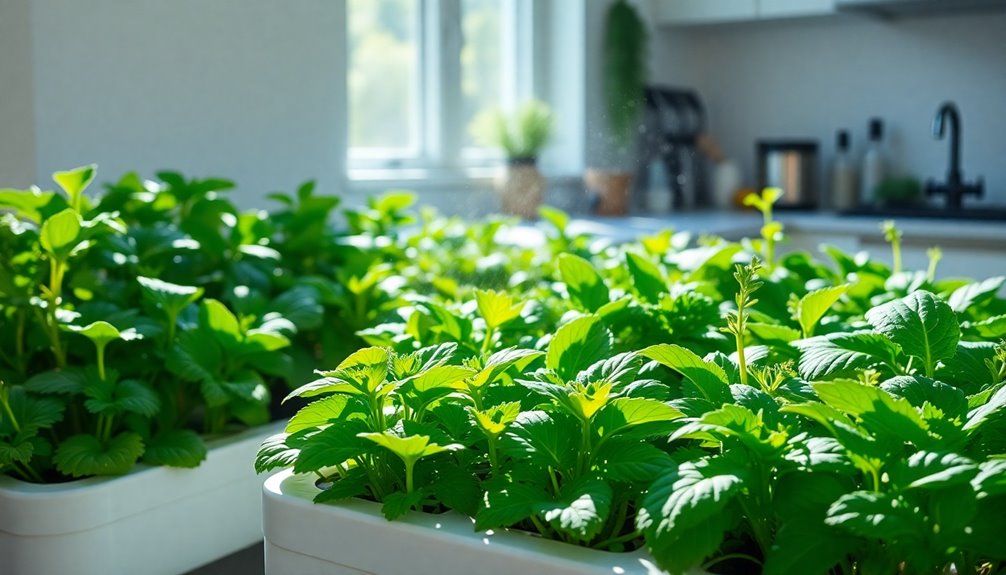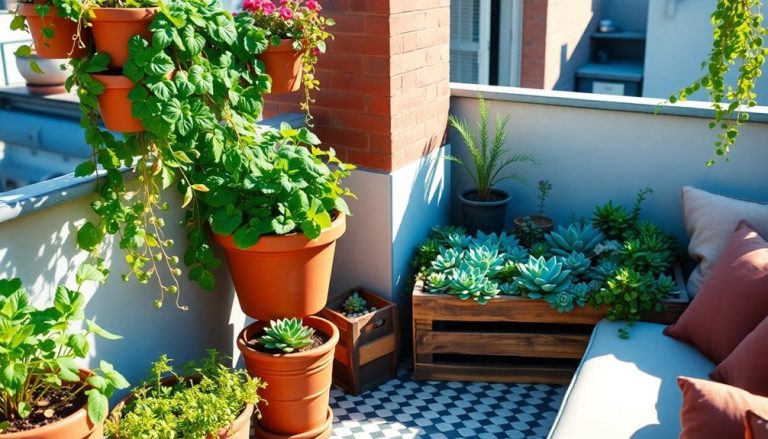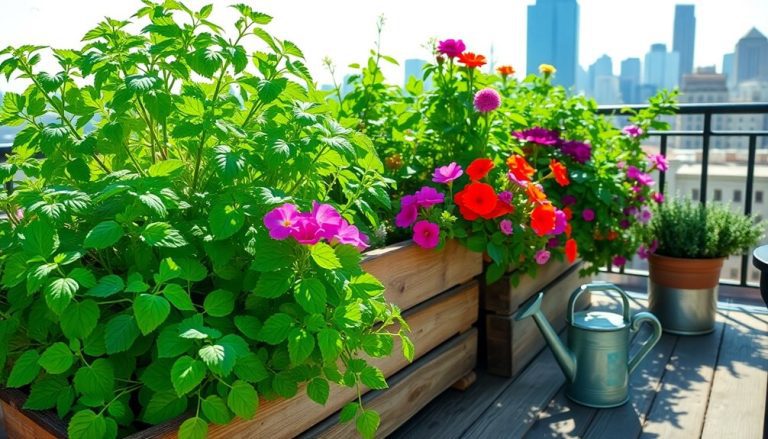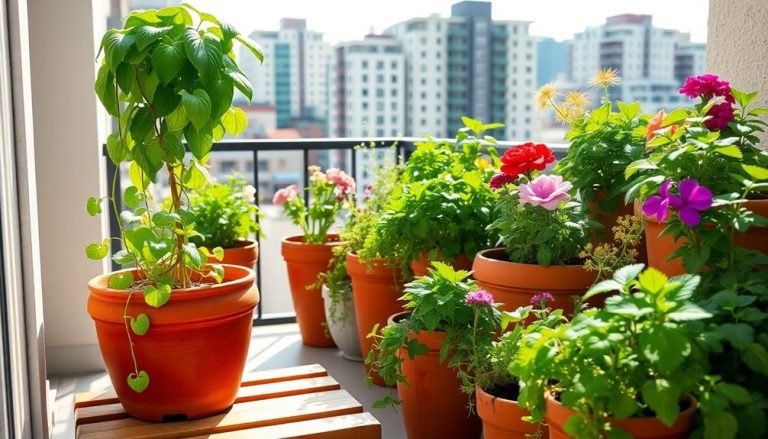Creating your own hydroponic garden at home is simpler than you think! Start by choosing the right system based on your space and budget. Options like nutrient film technique or deep water culture are popular for beginners. You'll need essential supplies like growing mediums, nutrient solutions, and a pH testing kit. Consider starting with leafy greens or herbs, as they thrive in hydroponics with minimal care. Regularly check nutrient levels and maintain pH balance to ensure healthy growth. With the right setup and care, you'll enjoy fresh produce in no time. Stick around to explore more tips and techniques!
Key Takeaways
- Choose a suitable hydroponic system based on your available space and the types of plants you wish to grow.
- Select appropriate growing mediums like rock wool or coconut coir for root support and nutrient absorption.
- Invest in essential supplies such as nutrient solutions, pH testing kits, and grow lights for optimal plant growth.
- Start with easy-to-grow plants like leafy greens and herbs for a successful initial experience in hydroponics.
- Regularly monitor pH levels, nutrient concentrations, and water quality to maintain a healthy hydroponic garden.
Understanding Hydroponics
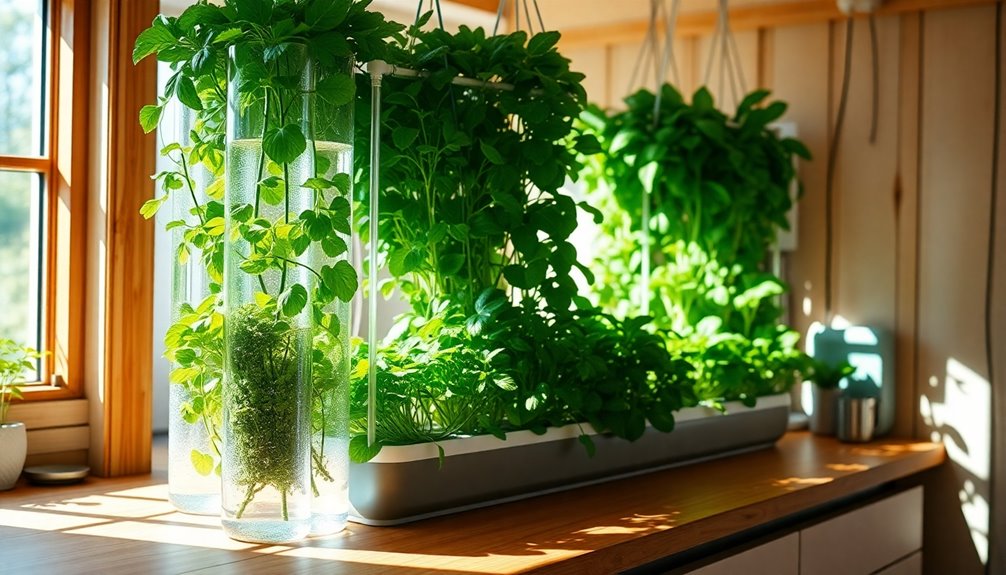
Understanding hydroponics is essential for anyone looking to grow plants without soil. This innovative method allows you to cultivate plants in nutrient-rich water, providing them with all the essential elements they need to thrive.
Instead of relying on soil, hydroponics uses various growing mediums, such as rock wool or clay pellets, to anchor the plants while the roots absorb nutrients from the water. Hydroponics systems can be tailored to specific plant requirements, ensuring optimal growth conditions for each type of plant.
With hydroponics, you can control the environment, which leads to faster growth and higher yields. You'll notice that plants often grow more quickly than in traditional gardening since they receive direct access to nutrients and oxygen.
You can also minimize pests and diseases, as there's no soil to harbor them. Additionally, implementing hydroponic solutions online can help you find the right products and systems to get started with your home garden.
Choosing the Right Hydroponic System
When it comes to choosing the right hydroponic system for your home, you'll find a variety of options designed to suit different needs and spaces.
First, consider the size of your available area. If you're short on space, a vertical system or a small container garden may be ideal. For larger areas, you might explore systems like deep water culture or nutrient film technique. Additionally, implementing a drip irrigation system can enhance water efficiency in larger hydroponic setups.
Next, think about the types of plants you want to grow. Some systems work better for leafy greens, while others are more suitable for fruiting plants. For instance, if you're aiming for tomatoes or peppers, a more robust system with support structures is essential.
Don't forget to factor in your budget and maintenance commitment. Some systems require more initial investment and ongoing upkeep. A simple Kratky method or a basic wick system might be perfect for beginners looking for low-maintenance options.
Finally, research the different hydroponic methods, such as aeroponics or aquaponics, to find what aligns best with your preferences and lifestyle. Additionally, consider incorporating raised garden beds into your hydroponic setup to maximize your gardening space and yield.
With the right choice, you'll be well on your way to a thriving hydroponic garden at home!
Essential Supplies for Hydroponic Gardening
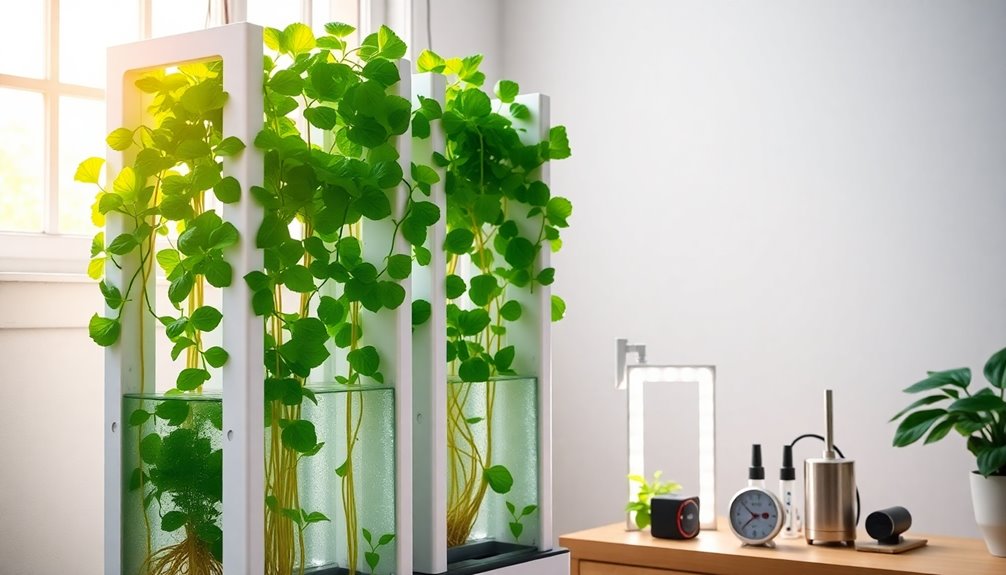
To start your hydroponic garden, you'll need several essential supplies that ensure your plants thrive.
These items are crucial for creating an efficient and effective growing environment. Let's go over the basics you'll need to get started.
– Growing Medium: Unlike soil, hydroponic systems rely on mediums like coconut coir, perlite, or rock wool to support plant roots while facilitating nutrient absorption.
Choose one that fits your system and plant types.
– Nutrient Solution: Plants need nutrients to grow, and in hydroponics, you'll need a specially formulated Nutrient Solution.
Look for a balanced mix that contains all the essential macro and micronutrients, which can be found in quality plant food online.
– pH Testing Kit: Maintaining the right pH level is vital for nutrient uptake.
A pH testing kit will help you monitor and adjust the acidity of your nutrient solution, ensuring your plants receive what they need.
Selecting Plants for Your Garden
Choosing the right plants for your hydroponic garden can significantly impact your success. Start by considering the space you have available and how much light your setup will get.
Leafy greens like lettuce, spinach, and kale thrive in hydroponic systems and grow quickly, making them ideal for beginners. If you prefer herbs, basil, mint, and cilantro are great options that require minimal care.
You might also want to explore growing strawberries or cherry tomatoes, which can adapt well to hydroponics, but keep in mind they may need more attention and support as they mature. When selecting plants, ensure they've similar nutrient and light requirements to simplify your maintenance.
Additionally, consider your climate and the growth cycle of the plants. Some may flourish in cooler temperatures, while others prefer warmth.
Start small and gradually expand your garden as you gain experience. Pay attention to the seed variety and choose those that are specifically suited for hydroponic systems to maximize your chances of success.
With the right plant choices, you'll be well on your way to enjoying a thriving hydroponic garden at home.
Setting Up Your Hydroponic System
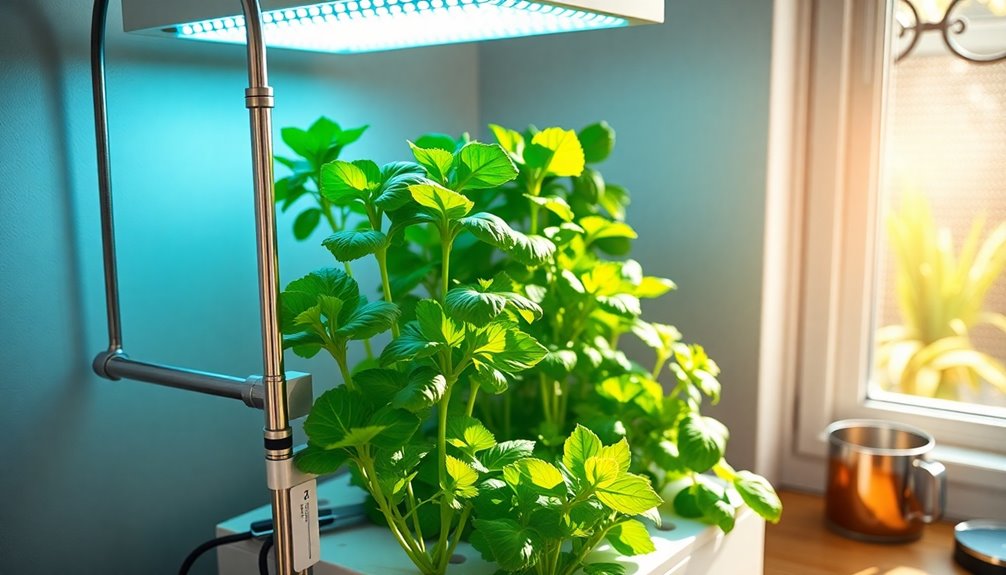
Setting up your hydroponic system is an exciting step toward growing fresh produce at home. To get started, choose a suitable location that has access to natural light or plan for artificial grow lights. You'll want a space where you can maintain a stable temperature and humidity.
Next, gather your materials. Depending on your chosen hydroponic method—like deep water culture, nutrient film technique, or aeroponics—you'll need specific equipment.
Here's a quick checklist to help you get organized:
- Container or System: Decide on the type of hydroponic system that suits your space and budget.
- Growing Medium: Select an appropriate growing medium like rock wool, clay pellets, or coconut coir.
- Nutrient Solution: Purchase a balanced nutrient solution designed for hydroponics.
Once you have everything ready, set up your system according to the manufacturer's instructions. Fill your containers with the growing medium, add the nutrient solution, and transplant your chosen plants.
With your hydroponic system in place, you're set to enjoy the rewarding experience of growing fresh produce right at home!
Maintaining Your Hydroponic Garden
Maintaining your hydroponic garden is crucial for ensuring healthy plant growth and maximizing your yield. Regular monitoring of nutrient levels, pH balance, and water quality keeps your plants thriving. Check the nutrient solution weekly, adjusting as needed to maintain optimal levels for your specific crops.
Here's a quick reference table to help you keep track of essential maintenance tasks:
| Task | Frequency | Notes |
|---|---|---|
| Check pH levels | Weekly | Aim for 5.5 – 6.5 |
| Monitor EC levels | Weekly | Ideal range varies by crop |
| Change nutrient solution | Every 2-3 weeks | Prevents buildup of harmful salts |
| Inspect plants | Daily | Look for pests, diseases, or wilting |
Don't forget to clean your system regularly to prevent algae growth and clogs. Replace any damaged parts promptly to maintain efficiency. With these practices in place, you'll foster a vibrant hydroponic garden that produces bountiful harvests all year round. Stay consistent, and enjoy the fruits of your labor!
Frequently Asked Questions
Can I Use Regular Soil in a Hydroponic System?
You can't use regular soil in a hydroponic system. Soil retains moisture and nutrients, which contradicts hydroponics' water-based approach. Instead, opt for a soilless medium to ensure proper drainage and nutrient delivery for your plants.
How Much Time Does Hydroponic Gardening Require Weekly?
Hydroponic gardening typically requires about 3 to 5 hours weekly. You'll need to monitor nutrient levels, adjust pH, and check for pests. It's manageable, but consistent care ensures healthier plants and better yields.
Is Hydroponic Gardening Suitable for Beginners?
Yes, hydroponic gardening's suitable for beginners! You'll find it simple to start, as it requires minimal space and can be done indoors. With a little practice, you'll quickly gain confidence and enjoy the process.
What Is the Average Cost to Start a Hydroponic Garden?
The average cost to start a hydroponic garden can range from $200 to $500, depending on the system you choose. You'll need to consider equipment, seeds, and nutrients when budgeting for your setup.
Can Hydroponic Systems Be Used Outdoors?
Absolutely! Hydroponic systems can thrive outdoors, turning your garden into a lush oasis. Just ensure you protect your plants from extreme weather and pests, and you'll enjoy bountiful harvests right in your backyard.
Conclusion
In conclusion, starting your own hydroponic garden at home can be a rewarding experience that brings fresh produce right to your kitchen. With the right system and care, you'll be amazed at how easy it is to grow your favorite plants without soil. So, why not take the plunge and cultivate your green thumb? Embrace the journey of hydroponics, and soon you'll enjoy the fruits of your labor in no time!

